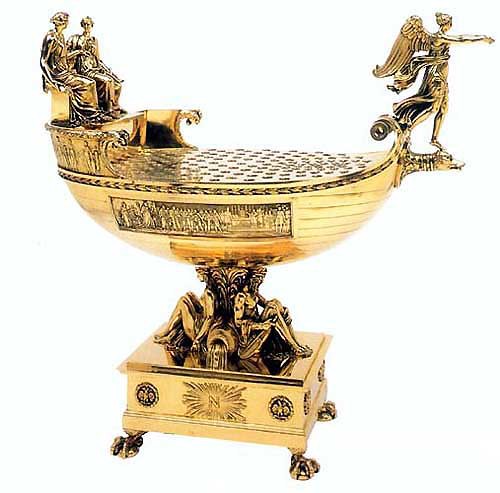With the proclamation of Empire in 1804 came the re-establishment of a ceremonial for every aspect of the sovereigns' and court's official life. The «Etiquette du Palais Impérial» composed by M. de Ségur, the Grand Master of Ceremonies, includes protocol for absolutely every single moment of court life. 'Their Majesties' Repast' was no exception. Three types of meal were specified: Grand Couvert (formal meal), Petit Couvert (less formal meal) and service in the private apartments. The Grand Couvert was directly descended from the monarchical tradition of the Ancien Régime and reserved for major events. It required a formal and grand table setting appropriate to the imperial dignity. A service of prestige tableware was offered to the Emperor by the Ville de Paris on the occasion of the coronation. Frochot, the Préfet de la Seine, commissioned the goldsmith Henry Auguste to make the sumptuous ensemble at the end of September 1804. It took 150 craftsmen two months to get it ready, and it was presented at an official ceremony on 16 December during a fête given in honour of the sovereigns at the Hôtel de Ville.
The Grand Vermeil service comprised more than 1000 pieces and was used to decorate the imperial table at some of the Empire's most prestigious occasions, such as for example the marriage banquet for Napoleon and Marie-Louise. Only 24 pieces of this remarkable ensemble have come down to us, one of which being this extraordinary table boat. Boats had been used by kings and queens as a table decoration since the 14th century; originally they were used to contain spices, but later their function was to hold serviettes set amongst sented cushions. The Emperor's table boat, just like the Empress's companion table boat, is in the form of a vessel, itself making allusion to the arms of the Ville de Paris (a boat). The ship is borne by two figures, the Seine and the Marne (themselves sitting upon a base bearing eagles and imperial Ns), and is decorated at the stern with the allegorical figures of Justice and Prudence watching over the crown of Charlemagne, whilst at the prow stands Renown. On the sides and to the rear there are three bas-reliefs: the coronation of the Emperor; the presentation of the service by Frochot and the maires of the twelve arrondissements; the twelve Parisian municipalities. The cover is dotted with bees. The Empress's table boat has the same form but differs in its allegories and bas-reliefs, in that they concentrate upon Josephine's generosity and her inclination for the arts.
Karine Huguenaud (tr. P.H.)
November 2002
The Emperor’s table ‘boat’
Artist(s) : AUGUSTE Henry

- Date :
- 1804
- Technique :
- vermeil or gilded silver
- Dimensions :
- H = 0.680 m, L = 0.720 m
- Place held :
- Musée National du Château de Fontainebleau - Musée Napoléon Ier
- Photo credit :
- © RMN

